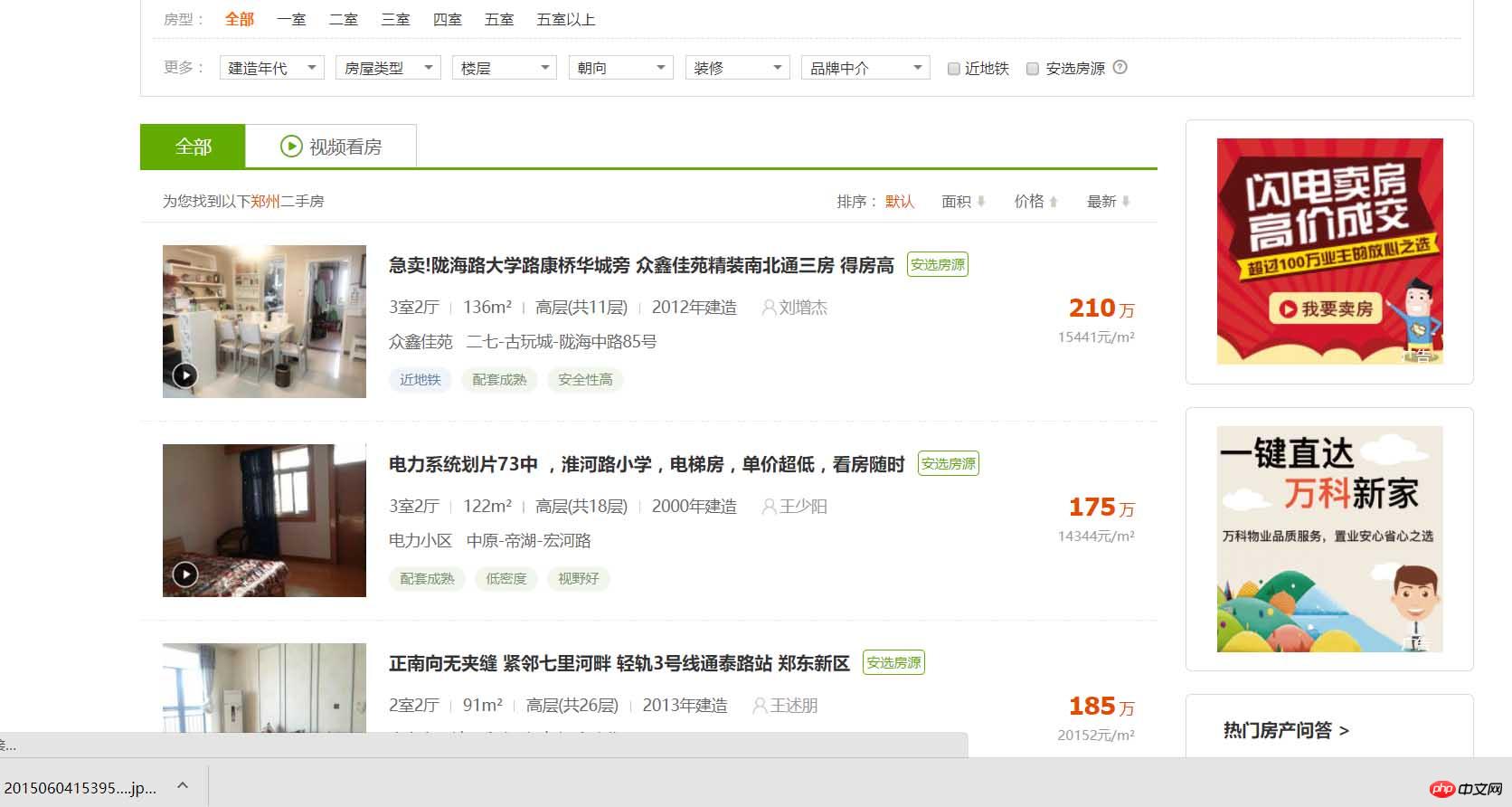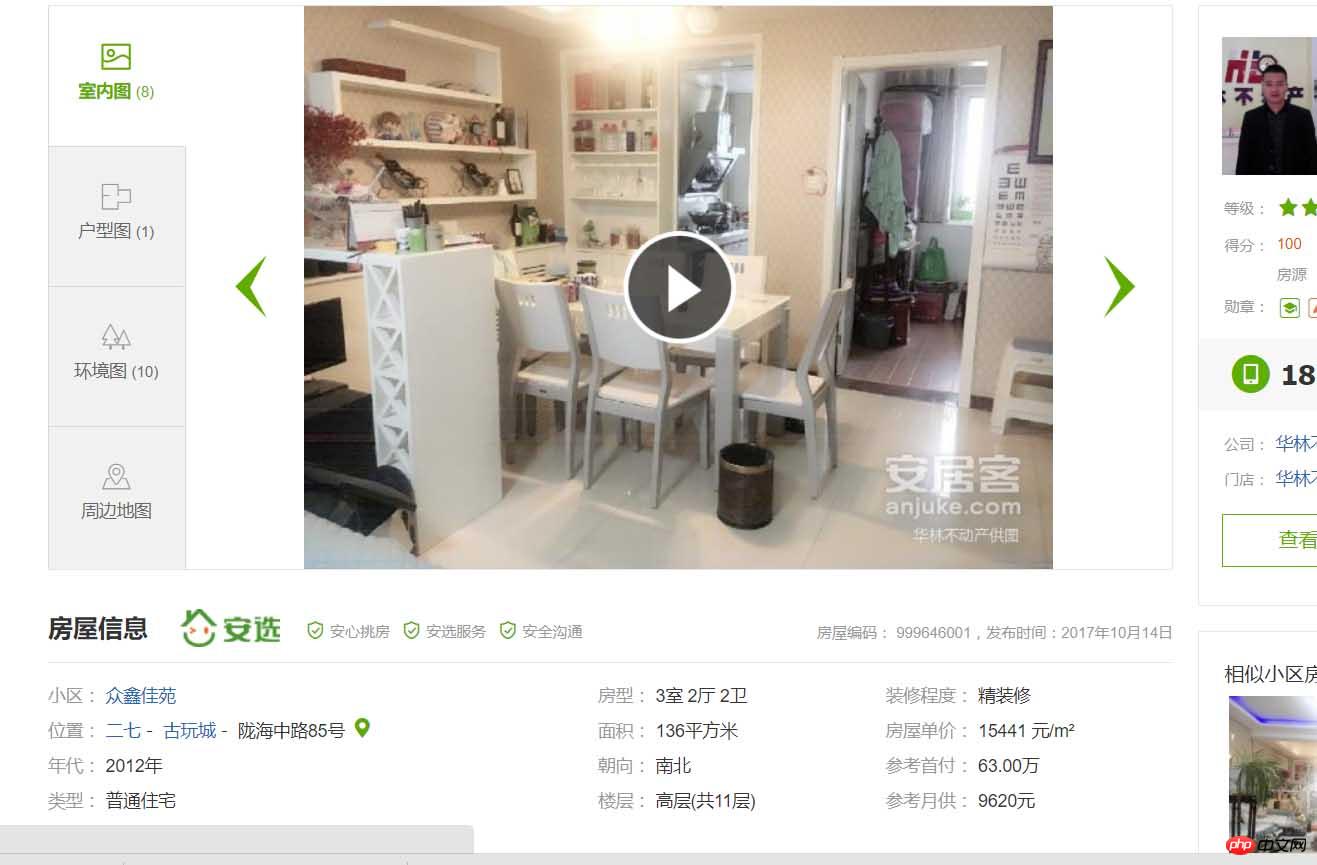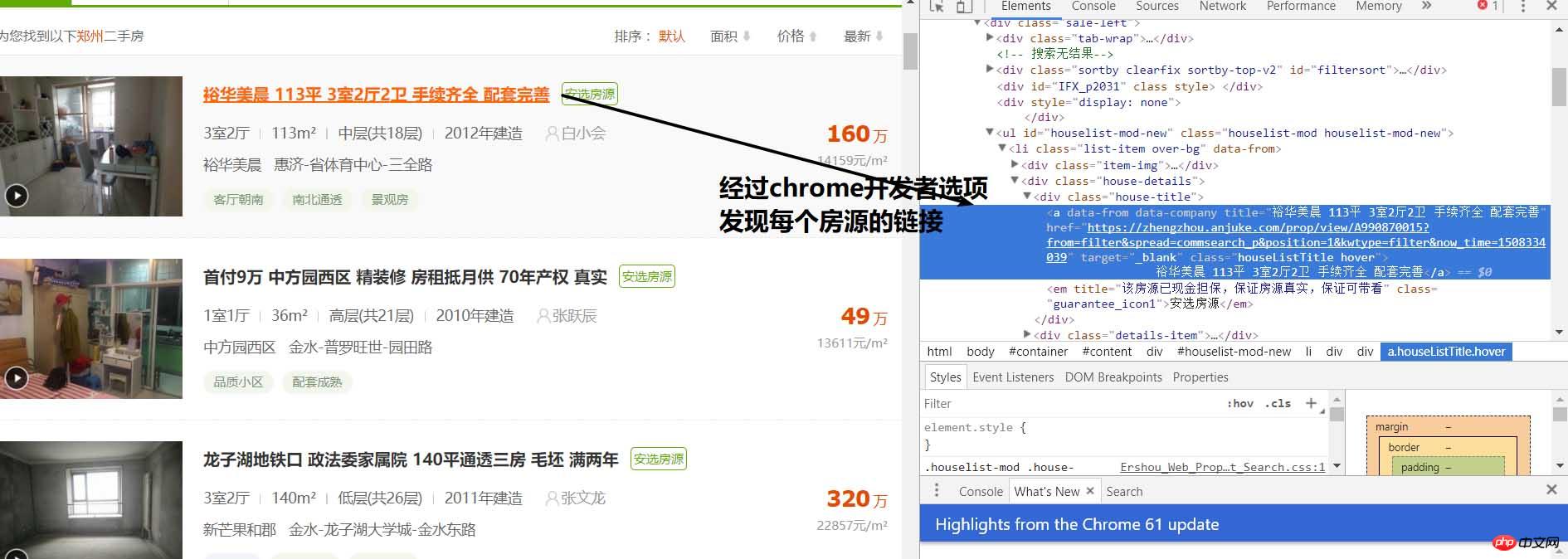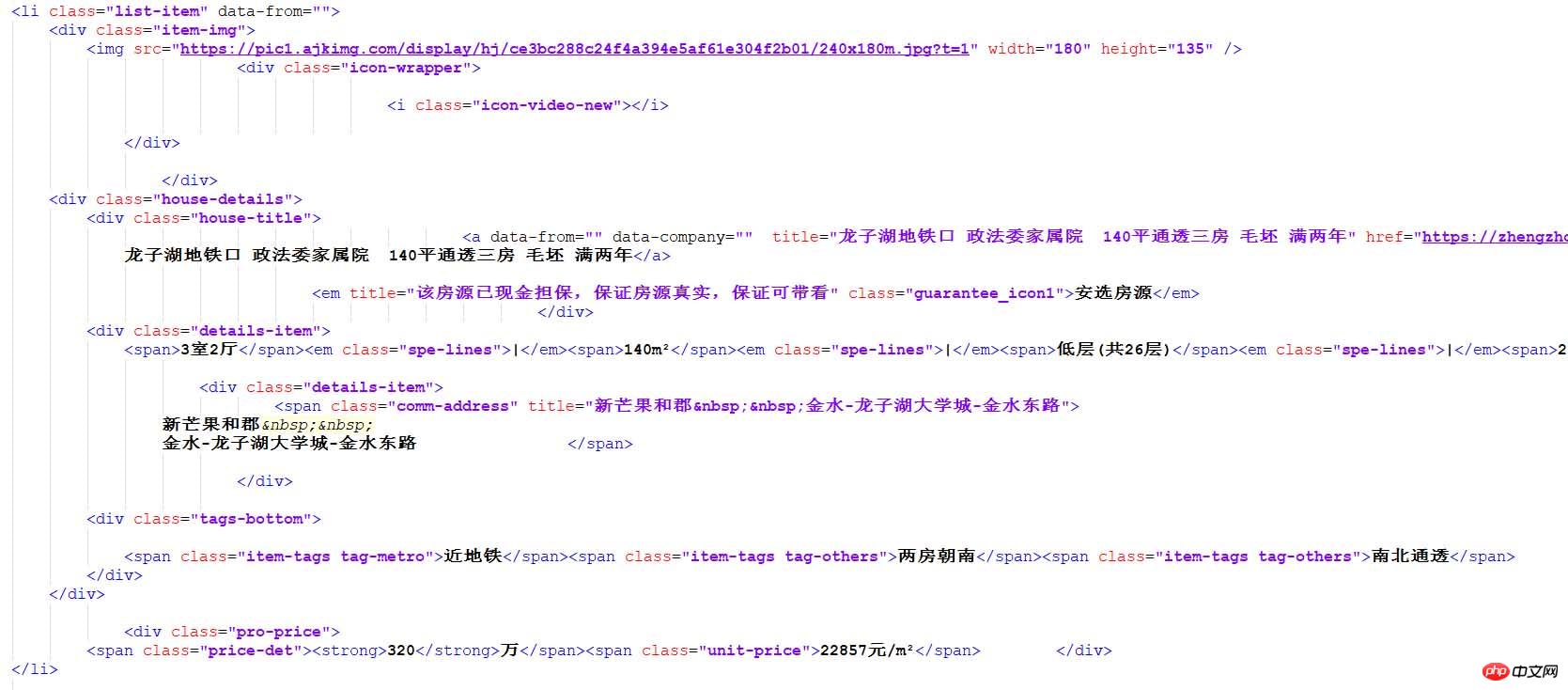 Backend Development
Backend Development
 Python Tutorial
Python Tutorial
 Python crawling method of Anjuke second-hand housing website data sharing
Python crawling method of Anjuke second-hand housing website data sharing
Python crawling method of Anjuke second-hand housing website data sharing
This article mainly brings you a python crawling of Anjuke second-hand housing website data (explanation with examples). The editor thinks it’s pretty good, so I’ll share it with you now and give it as a reference. Let’s follow the editor to take a look, I hope it can help everyone.
Now we will start to officially write the crawler. First, we need to analyze the structure of the website to be crawled: As a student in Henan, let’s take a look at the second-hand housing information in Zhengzhou! 
In the above page, we can see the property information one by one. From the above, we can see the property information one by one on the web page. After clicking in, you will find:

Details of the property. OK! So what are we going to do? That is to get all the second-hand housing information in Zhengzhou and save it in the database. What is it used for? As a geographer, it is still somewhat useful. I won’t go into it this time. Okay, let’s officially start. First, I use the requests and BeautifulSoup modules in python3.6 to crawl the page. First, the requests module makes the request:
# 网页的请求头
header = {
'user-agent': 'Mozilla/5.0 (Windows NT 10.0; WOW64) AppleWebKit/537.36 (KHTML, like Gecko) Chrome/60.0.3112.113 Safari/537.36'
}
# url链接
url = 'https://zhengzhou.anjuke.com/sale/'
response = requests.get(url, headers=header)
print(response.text)After execution, You will get the html code of this website

 Through analysis, you can get that each house is in the li tag of class="list-item", then we can proceed based on the BeautifulSoup package Extracting
Through analysis, you can get that each house is in the li tag of class="list-item", then we can proceed based on the BeautifulSoup package Extracting
# 通过BeautifulSoup进行解析出每个房源详细列表并进行打印
soup = BeautifulSoup(response.text, 'html.parser')
result_li = soup.find_all('li', {'class': 'list-item'})
for i in result_li:
print(i)can further reduce the amount of code by printing. OK, continue to extract
# 通过BeautifulSoup进行解析出每个房源详细列表并进行打印
soup = BeautifulSoup(response.text, 'html.parser')
result_li = soup.find_all('li', {'class': 'list-item'})
# 进行循环遍历其中的房源详细列表
for i in result_li:
# 由于BeautifulSoup传入的必须为字符串,所以进行转换
page_url = str(i)
soup = BeautifulSoup(page_url, 'html.parser')
# 由于通过class解析的为一个列表,所以只需要第一个参数
result_href = soup.find_all('a', {'class': 'houseListTitle'})[0]
print(result_href.attrs['href']). In this way, we You can see the URLs one by one. Do you like it? 
Okay, according to normal logic, you have to enter the page and start analyzing the detailed page, but how to proceed to the next page after crawling? So, we need to first analyze whether the page has a next page

The same method can be used to find that the next page is also so simple, then we You can continue with the original recipe and original taste
# 进行下一页的爬取
result_next_page = soup.find_all('a', {'class': 'aNxt'})
if len(result_next_page) != 0:
print(result_next_page[0].attrs['href'])
else:
print('没有下一页了')Because when the next page exists, there is an a tag in the web page. If not, it will become i tag, so this will do. Therefore, we can improve it and encapsulate the above into a function
import requests
from bs4 import BeautifulSoup
# 网页的请求头
header = {
'user-agent': 'Mozilla/5.0 (Windows NT 10.0; WOW64) AppleWebKit/537.36 (KHTML, like Gecko) Chrome/60.0.3112.113 Safari/537.36'
}
def get_page(url):
response = requests.get(url, headers=header)
# 通过BeautifulSoup进行解析出每个房源详细列表并进行打印
soup = BeautifulSoup(response.text, 'html.parser')
result_li = soup.find_all('li', {'class': 'list-item'})
# 进行下一页的爬取
result_next_page = soup.find_all('a', {'class': 'aNxt'})
if len(result_next_page) != 0:
# 函数进行递归
get_page(result_next_page[0].attrs['href'])
else:
print('没有下一页了')
# 进行循环遍历其中的房源详细列表
for i in result_li:
# 由于BeautifulSoup传入的必须为字符串,所以进行转换
page_url = str(i)
soup = BeautifulSoup(page_url, 'html.parser')
# 由于通过class解析的为一个列表,所以只需要第一个参数
result_href = soup.find_all('a', {'class': 'houseListTitle'})[0]
# 先不做分析,等一会进行详细页面函数完成后进行调用
print(result_href.attrs['href'])
if __name__ == '__main__':
# url链接
url = 'https://zhengzhou.anjuke.com/sale/'
# 页面爬取函数调用
get_page(url)Okay, then let’s start the detailed page Crawled
Hey, the power is always cut off, what a trap in the university, I will attach the results first, I will add more when I have free time,
import requests
from bs4 import BeautifulSoup
# 网页的请求头
header = {
'user-agent': 'Mozilla/5.0 (Windows NT 10.0; WOW64) AppleWebKit/537.36 (KHTML, like Gecko) Chrome/60.0.3112.113 Safari/537.36'
}
def get_page(url):
response = requests.get(url, headers=header)
# 通过BeautifulSoup进行解析出每个房源详细列表并进行打印
soup_idex = BeautifulSoup(response.text, 'html.parser')
result_li = soup_idex.find_all('li', {'class': 'list-item'})
# 进行循环遍历其中的房源详细列表
for i in result_li:
# 由于BeautifulSoup传入的必须为字符串,所以进行转换
page_url = str(i)
soup = BeautifulSoup(page_url, 'html.parser')
# 由于通过class解析的为一个列表,所以只需要第一个参数
result_href = soup.find_all('a', {'class': 'houseListTitle'})[0]
# 详细页面的函数调用
get_page_detail(result_href.attrs['href'])
# 进行下一页的爬取
result_next_page = soup_idex.find_all('a', {'class': 'aNxt'})
if len(result_next_page) != 0:
# 函数进行递归
get_page(result_next_page[0].attrs['href'])
else:
print('没有下一页了')
# 进行字符串中空格,换行,tab键的替换及删除字符串两边的空格删除
def my_strip(s):
return str(s).replace(" ", "").replace("\n", "").replace("\t", "").strip()
# 由于频繁进行BeautifulSoup的使用,封装一下,很鸡肋
def my_Beautifulsoup(response):
return BeautifulSoup(str(response), 'html.parser')
# 详细页面的爬取
def get_page_detail(url):
response = requests.get(url, headers=header)
if response.status_code == 200:
soup = BeautifulSoup(response.text, 'html.parser')
# 标题什么的一大堆,哈哈
result_title = soup.find_all('h3', {'class': 'long-title'})[0]
result_price = soup.find_all('span', {'class': 'light info-tag'})[0]
result_house_1 = soup.find_all('p', {'class': 'first-col detail-col'})
result_house_2 = soup.find_all('p', {'class': 'second-col detail-col'})
result_house_3 = soup.find_all('p', {'class': 'third-col detail-col'})
soup_1 = my_Beautifulsoup(result_house_1)
soup_2 = my_Beautifulsoup(result_house_2)
soup_3 = my_Beautifulsoup(result_house_3)
result_house_tar_1 = soup_1.find_all('dd')
result_house_tar_2 = soup_2.find_all('dd')
result_house_tar_3 = soup_3.find_all('dd')
'''
文博公寓,省实验中学,首付只需70万,大三房,诚心卖,价可谈 270万
宇泰文博公寓 金水-花园路-文博东路4号 2010年 普通住宅
3室2厅2卫 140平方米 南北 中层(共32层)
精装修 19285元/m² 81.00万
'''
print(my_strip(result_title.text), my_strip(result_price.text))
print(my_strip(result_house_tar_1[0].text),
my_strip(my_Beautifulsoup(result_house_tar_1[1]).find_all('p')[0].text),
my_strip(result_house_tar_1[2].text), my_strip(result_house_tar_1[3].text))
print(my_strip(result_house_tar_2[0].text), my_strip(result_house_tar_2[1].text),
my_strip(result_house_tar_2[2].text), my_strip(result_house_tar_2[3].text))
print(my_strip(result_house_tar_3[0].text), my_strip(result_house_tar_3[1].text),
my_strip(result_house_tar_3[2].text))
if __name__ == '__main__':
# url链接
url = 'https://zhengzhou.anjuke.com/sale/'
# 页面爬取函数调用
get_page(url)Since I wrote the code while blogging, I made some changes in the get_page function, that is, the recursive call for the next page needs to be placed after the function, and the two functions are encapsulated without introduction,
And the data is not written to mysql, so I will continue to follow up later, thank you!!!
Related recommendations:
python crawling article example tutorial
10 recommended articles about python crawling
Share a Python method to crawl popular comments on NetEase Cloud Music
The above is the detailed content of Python crawling method of Anjuke second-hand housing website data sharing. For more information, please follow other related articles on the PHP Chinese website!

Hot AI Tools

Undresser.AI Undress
AI-powered app for creating realistic nude photos

AI Clothes Remover
Online AI tool for removing clothes from photos.

Undress AI Tool
Undress images for free

Clothoff.io
AI clothes remover

Video Face Swap
Swap faces in any video effortlessly with our completely free AI face swap tool!

Hot Article

Hot Tools

Notepad++7.3.1
Easy-to-use and free code editor

SublimeText3 Chinese version
Chinese version, very easy to use

Zend Studio 13.0.1
Powerful PHP integrated development environment

Dreamweaver CS6
Visual web development tools

SublimeText3 Mac version
God-level code editing software (SublimeText3)

Hot Topics
 PHP and Python: Different Paradigms Explained
Apr 18, 2025 am 12:26 AM
PHP and Python: Different Paradigms Explained
Apr 18, 2025 am 12:26 AM
PHP is mainly procedural programming, but also supports object-oriented programming (OOP); Python supports a variety of paradigms, including OOP, functional and procedural programming. PHP is suitable for web development, and Python is suitable for a variety of applications such as data analysis and machine learning.
 Choosing Between PHP and Python: A Guide
Apr 18, 2025 am 12:24 AM
Choosing Between PHP and Python: A Guide
Apr 18, 2025 am 12:24 AM
PHP is suitable for web development and rapid prototyping, and Python is suitable for data science and machine learning. 1.PHP is used for dynamic web development, with simple syntax and suitable for rapid development. 2. Python has concise syntax, is suitable for multiple fields, and has a strong library ecosystem.
 Python vs. JavaScript: The Learning Curve and Ease of Use
Apr 16, 2025 am 12:12 AM
Python vs. JavaScript: The Learning Curve and Ease of Use
Apr 16, 2025 am 12:12 AM
Python is more suitable for beginners, with a smooth learning curve and concise syntax; JavaScript is suitable for front-end development, with a steep learning curve and flexible syntax. 1. Python syntax is intuitive and suitable for data science and back-end development. 2. JavaScript is flexible and widely used in front-end and server-side programming.
 PHP and Python: A Deep Dive into Their History
Apr 18, 2025 am 12:25 AM
PHP and Python: A Deep Dive into Their History
Apr 18, 2025 am 12:25 AM
PHP originated in 1994 and was developed by RasmusLerdorf. It was originally used to track website visitors and gradually evolved into a server-side scripting language and was widely used in web development. Python was developed by Guidovan Rossum in the late 1980s and was first released in 1991. It emphasizes code readability and simplicity, and is suitable for scientific computing, data analysis and other fields.
 Can vs code run in Windows 8
Apr 15, 2025 pm 07:24 PM
Can vs code run in Windows 8
Apr 15, 2025 pm 07:24 PM
VS Code can run on Windows 8, but the experience may not be great. First make sure the system has been updated to the latest patch, then download the VS Code installation package that matches the system architecture and install it as prompted. After installation, be aware that some extensions may be incompatible with Windows 8 and need to look for alternative extensions or use newer Windows systems in a virtual machine. Install the necessary extensions to check whether they work properly. Although VS Code is feasible on Windows 8, it is recommended to upgrade to a newer Windows system for a better development experience and security.
 Can visual studio code be used in python
Apr 15, 2025 pm 08:18 PM
Can visual studio code be used in python
Apr 15, 2025 pm 08:18 PM
VS Code can be used to write Python and provides many features that make it an ideal tool for developing Python applications. It allows users to: install Python extensions to get functions such as code completion, syntax highlighting, and debugging. Use the debugger to track code step by step, find and fix errors. Integrate Git for version control. Use code formatting tools to maintain code consistency. Use the Linting tool to spot potential problems ahead of time.
 How to run python with notepad
Apr 16, 2025 pm 07:33 PM
How to run python with notepad
Apr 16, 2025 pm 07:33 PM
Running Python code in Notepad requires the Python executable and NppExec plug-in to be installed. After installing Python and adding PATH to it, configure the command "python" and the parameter "{CURRENT_DIRECTORY}{FILE_NAME}" in the NppExec plug-in to run Python code in Notepad through the shortcut key "F6".
 Is the vscode extension malicious?
Apr 15, 2025 pm 07:57 PM
Is the vscode extension malicious?
Apr 15, 2025 pm 07:57 PM
VS Code extensions pose malicious risks, such as hiding malicious code, exploiting vulnerabilities, and masturbating as legitimate extensions. Methods to identify malicious extensions include: checking publishers, reading comments, checking code, and installing with caution. Security measures also include: security awareness, good habits, regular updates and antivirus software.





